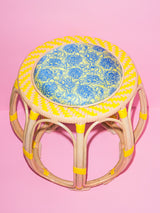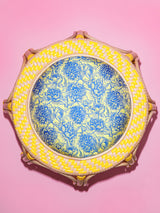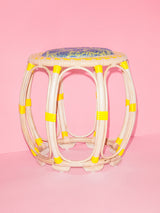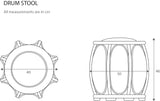Drum Stool (Yellow)
A natural rattan drum stool with a blue and yellow jacquard upholstered seat depicting peonies and a handwoven rim incorporating an indigenous Orang Ulu pattern. Rim weave and handbound detailing in yellow and natural-coloured synthetic rattan.
Collectible as a stool, side table or decorative object. Sturdy, slides easily under tables and stackable.
Construction
- Natural Rotan Manau (Calamus Manan) frame
- Natural Rotan Mantang (Plectocomia) underseat
- Natural Rotan Sega (Calamus Caesius) detailing
- Jacquard cushioned seat
- Synthetic rattan rim weave and binding
- Made in Malaysia from locally harvested rattan
Rattan’s porous quality allows it to be breathable and withstand humidity, perfect for tropical climates. However, avoid placement under direct sunlight and rain.
Maintenance is simple and should be carried out every few months. Vacuum or brush with toothbrush to loosen dust, then wipe down with a damp cloth. Leave to air dry.
Fabric panels should be coated with an upholstery protector every six months.
If you are investing in rattan furniture, it is important to appreciate rattan for what it is, and what is is not.
Here are some key characteristics to embrace:
Colour variations, markings, grains and dents
These are distinguishable “battlescars” of rattan canes, especially that of Rotan Manau, commercially accepted as the gold standard of rattan in terms of durability, strength and lifespan. These are not considered flaws or defects, but a sign of authenticity and quality of the rattan species used. They indicate the use of natural rattan that has not been masked with veneers or synthetic additives.
Crack marks
These occur when rattan canes are bent into shape to form the desired structures and frames that the furniture requires them to be in. Rattan grows in vertical shoots, similar to bamboo or sugar cane. In the bending processs, the canes are heated and manually bent - the heat softens the cane and allows it to be moulded. These cracks are therefore simply a natural process of rattan furniture making and have no detrimental value to the structural soundness of the frame.
Hairy strands
These are simply natural fibres of rattan. It is important to differentiate between non-timber and timber furniture. Non-timber materials like rattan are characteristically delicate and because of this, require a production process that cannot be replicated by machine and will therefore never be able to produce synthetic results achievable by mechanical means. While wood may be sandpapered down by machinery, rattan furniture can only be sandpapered by hand - leaving these fine strands intact.
Minor inconsistencies
The entirely handmade nature of rattan furniture means that no two pieces or sides of the same piece are exactly alike. Inconsistencies and imperfections should be expected and appreciated. They are inherent in a non-automated production process and do not affect the quality or value of the item. Remember that variation and inconsistencies are the keys to identifying authentically handmade furniture.












